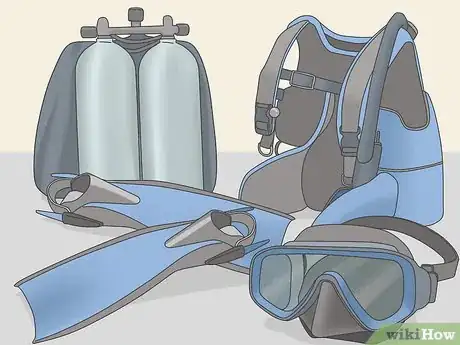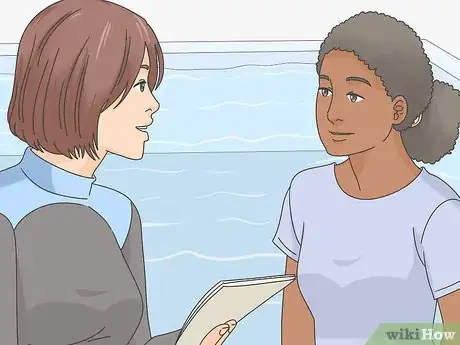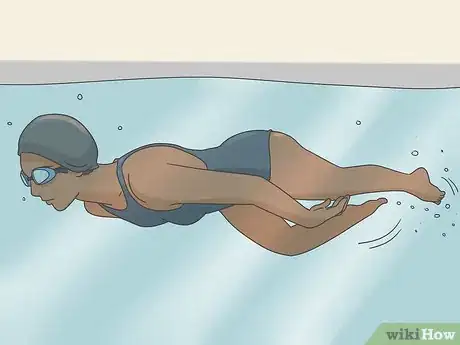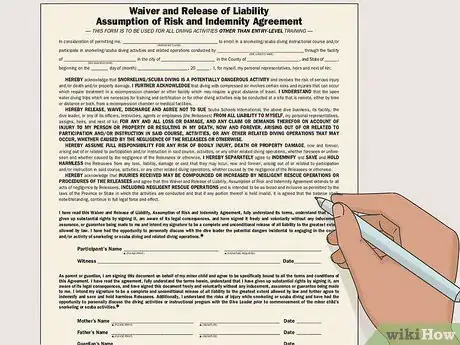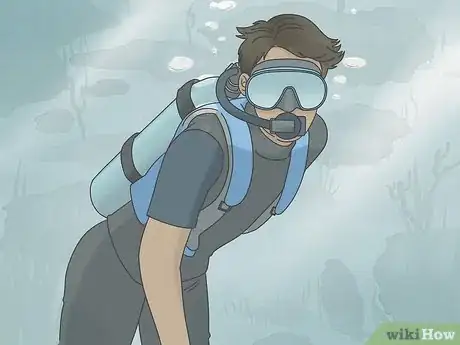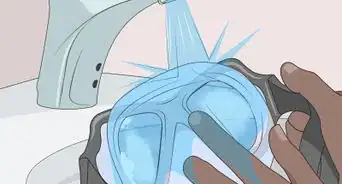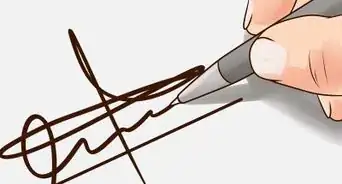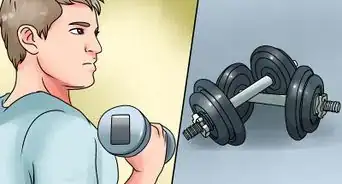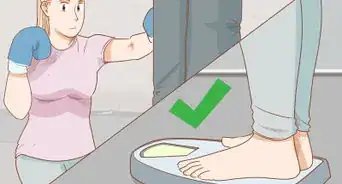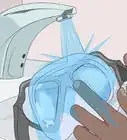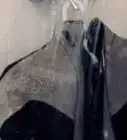This article was co-authored by wikiHow staff writer, Hannah Madden. Hannah Madden is a writer, editor, and artist currently living in Portland, Oregon. In 2018, she graduated from Portland State University with a B.S. in Environmental Studies. Hannah enjoys writing articles about conservation, sustainability, and eco-friendly products. When she isn’t writing, you can find Hannah working on hand embroidery projects and listening to music.
There are 9 references cited in this article, which can be found at the bottom of the page.
wikiHow marks an article as reader-approved once it receives enough positive feedback. In this case, several readers have written to tell us that this article was helpful to them, earning it our reader-approved status.
This article has been viewed 268,237 times.
Learn more...
The word scuba is an acronym for Self Contained Underwater Breathing Apparatus and refers to the equipment which allows properly trained scuba divers to safely explore the underwater environment. At the heart of a scuba diver’s training is learning how this equipment works and the procedures and techniques for its safe use. If you are trying to become a certified diver but you don’t know how, find a certified instructor to teach you and work toward your C-Card, a scuba diving certification card, by training with your equipment in a closed water environment.
Steps
Qualifying to Scuba Dive
-
1Be at least 12 years of age. You must be at least 12 years old to begin scuba diver training. If you are younger than 12, you may be able to participate in restricted, junior diver training programs sponsored by certain training agencies.[1]
- If you are under 12, check with your local scuba diving agencies to see if they have junior courses you can sign up for.
-
2Determine if you are medically fit to dive. Scuba diving is an active sport that requires a reasonable level of good health and physical fitness. If you have a seizure disorder, narcolepsy, or low blood pressure, you may not be able to dive. Check with your doctor if you have any concerns.[2]
- You can determine if you are fit for training and participation in the sport by reviewing a questionnaire used by the World Recreational Scuba Training Council. You can view the questionnaire by visiting http://wrstc.com/downloads/10%20-%20Medical%20Guidelines.pdf
Advertisement -
3Make sure you have all of the scuba equipment required for your classes. Scuba diving is an equipment intensive sport, and divers need a full set of scuba gear in order to participate. Standard scuba gear includes: A scuba mask, fins, buoyancy control device and harness, a primary and secondary regulator, twin decompression cylinders, a submersible pressure gauge, and a dry suit.[3]
- Some or all of this gear may be included in your course fee, or you may be able to rent it from a local dive store.
Signing up for Lessons
-
1Find a qualified scuba instructor to teach you. Locate a scuba instructor either through a referral from a friend or associate, an advertisement, or through a local dive store. Be sure your instructor has a current membership in their training agency and is in a "teaching" status. Their C-Card will tell you this. You should try to find someone who has experience in training divers from scratch.[4]
- Since there are multiple agencies that certify scuba divers, you can check with your instructor to see which one they will be guiding you toward in your class and decide if it is what you need.
- Select a facility that is close to your home or your place of work so that you can get there quickly.
- Find out exactly what your training will cost. Some instructors and dive stores charge a flat rate for complete certification, while others charge incrementally as training progresses. Ask your instructor what the total classroom and pool training will cost, and also what the charge is for the final Open Water training.[5]
Tip: If you find someone you like, ask to audit one or two of their classes before committing.
-
2Take the watermanship test. In order for you to begin a scuba training course, you must first demonstrate to an instructor your ability to swim continuously for 200 yards (180 m) and float for 10 minutes, both without aids. Alternatively, if you would like to swim using a mask, fins and a snorkel, you must swim continuously for 300 yards (270 m) and then float for 10 minutes without any aids.[6]
-
3Sign a liability waiver to acknowledge the risks of scuba diving. Fill out your medical and fitness guidelines to let your instructor know of any added risks you might have. Then, sign a liability waiver from your instructor acknowledging that you understand you will be liable for any accidents that occur while you scuba dive, not your instructor or dive school.[7]
- Most instructors will not teach you how to scuba dive until you have signed a liability waiver.
Learning How to Dive and Testing Your Skills
-
1Study the safety rules of scuba diving through your course. Read the book, watch the DVD, and do the on-line course work that you are assigned. The academic portion of a scuba course teaches you the theory of diving and the procedures necessary to do it safely. Usually, these courses are divided into short segments with quizzes that generally following each topic and a final exam at the end to assess your understanding of the material.[8]
- Some courses provide a classroom setting, while others can be taken online.
Tip: If you don’t pass the final exam on the first try, many courses allow re-dos.
-
2Practice your diving skills in a pool with your instructor. The Confined Water portion of a scuba course is where the heart of the training occurs. This is where you will learn the function of all of your equipment and how to use it safely. You will be taught to clear water from a flooded mask, breathe from a regulator, use fins properly, and control your buoyancy by adding or venting air from your buoyancy control device, along with a myriad of other skills.[9]
- A scuba diving course can take anywhere from a few days to a couple of weeks. It’s up to you and your instructor to set your timeline and stick to it.
-
3Complete your Open Water training and certification dives. The final step toward becoming a certified scuba diver is to complete 4 open water training dives under the supervision of an instructor. These dives are conducted in a large body of water, like an ocean or lake, over 2 or more days. On these Open Water dives, your instructor will have you demonstrate to him or her that you are capable of doing what you learned to do in the pool.[10]
- Flooding and clearing your mask, descending to the bottom, recovering a misplaced regulator, and ascending to the surface are all skills you could be tested on.
-
4Get your C-Card from your instructor. Once you successfully complete the 4 required open water dives, your instructor will advise the training agency to issue a C-Card in your name. Your C-card vouches for your training and qualifies you to obtain air fills or rental tanks, buy or rent scuba equipment, and engage in recreational open water diving in conditions similar to those under which you trained without further supervision.[11]
- There are multiple agencies that certify scuba divers, including PADI, NAUI, BSAC, and CMAS. Check into each agency and determine which certification is right for you.
Community Q&A
Did you know you can get answers researched by wikiHow Staff?
Unlock staff-researched answers by supporting wikiHow
-
QuestionWhat is the total cost of the course for all certifications?
 wikiHow Staff EditorThis answer was written by one of our trained team of researchers who validated it for accuracy and comprehensiveness.
wikiHow Staff EditorThis answer was written by one of our trained team of researchers who validated it for accuracy and comprehensiveness.
Staff Answer wikiHow Staff EditorStaff Answer
wikiHow Staff EditorStaff Answer -
QuestionHow can I tread water without hands?
 TaraCommunity AnswerBob your feet up and down to keep your balance, using your core to assist. (You can keep your legs farther apart for better balance.)
TaraCommunity AnswerBob your feet up and down to keep your balance, using your core to assist. (You can keep your legs farther apart for better balance.) -
QuestionWhat is the difference between NAUI, PADI, and SSI certification details?
 NormanPapermanCommunity AnswerThere isn't too much difference between the basic certification courses. However, the structure of more advanced courses can vary, as can availability of those courses. PADI is the most universally available, followed by SSI and SDI.
NormanPapermanCommunity AnswerThere isn't too much difference between the basic certification courses. However, the structure of more advanced courses can vary, as can availability of those courses. PADI is the most universally available, followed by SSI and SDI.
Warnings
- Scuba diving is a sport that requires specific knowledge, equipment and skills to be done safely. Please do not attempt scuba diving, even in a pool, without complete training unless you are under the supervision of an instructor.⧼thumbs_response⧽
- Always be in supervision of a buddy. Never scuba dive alone!⧼thumbs_response⧽
References
- ↑ http://padi.com/courses/scuba-diver
- ↑ http://wrstc.com/downloads/10%20-%20Medical%20Guidelines.pdf
- ↑ https://www.padi.com/help/gear-faq
- ↑ https://xray-mag.com/content/choose-wisely-how-spot-good-dive-instructor
- ↑ https://www.padi.com/help/scuba-certification-faq
- ↑ https://www.diverescueintl.com/wp-content/uploads/2014/02/IADRS-Watermanship-Test-2011.pdf
- ↑ https://www.divedominica.com/wp-content/uploads/2016/07/CertifiedDiver-LiabilityRelease.pdf
- ↑ https://www.padi.com/padi-elearning
- ↑ https://www.padi.com/help/scuba-certification-faq
About This Article
To become a certified scuba diver, you’ll need to learn how the equipment works and the techniques to use it safely. To qualify to scuba dive, you’ll need to be at least 12 years old and medically fit to dive. For example, if you have a seizure disorder, narcolepsy, or low blood pressure, you’ll want to check with your doctor first. If you meet the basic requirements, then find a qualified scuba instructor to teach you. To begin a scuba training course, you’ll have to show your instructor that you can swim continuously for 200 yards and float for 10 minutes. During the course, you'll need to study the safety rules and will be able to practice your diving skills in a pool with your instructor. Finally, you'll need to complete 4 open water training dives to get your C-card. To learn how to find a certified scuba instructor, keep reading!


